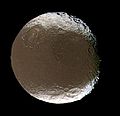Fichier:Iapetus Spins and Tilts.jpg
Iapetus_Spins_and_Tilts.jpg (361 × 349 pixels, taille du fichier : 13 kio, type MIME : image/jpeg)
Historique du fichier
Cliquer sur une date et heure pour voir le fichier tel qu'il était à ce moment-là.
| Date et heure | Vignette | Dimensions | Utilisateur | Commentaire | |
|---|---|---|---|---|---|
| actuel | 5 décembre 2015 à 04:36 |  | 361 × 349 (13 kio) | PlanetUser | Cropped 42 % horizontally and 42 % vertically using CropTool with precise mode. |
| 10 octobre 2006 à 22:04 |  | 618 × 605 (18 kio) | Uwe W. | '''Original Caption Released with Image:''' Saturn's two-faced moon tilts and rotates for Cassini in this mesmerizing movie sequence of images acquired during the spacecraft's close encounter with Iapetus on Nov. 12, 2005. The encounter begins with Cas |
Utilisation du fichier
La page suivante utilise ce fichier :
Usage global du fichier
Les autres wikis suivants utilisent ce fichier :
- Utilisation sur af.wikipedia.org
- Utilisation sur an.wikipedia.org
- Utilisation sur de.wikipedia.org
- Utilisation sur en.wikipedia.org
- Utilisation sur en.wikiversity.org
- Utilisation sur ja.wikipedia.org
- Utilisation sur ko.wikipedia.org
- Utilisation sur lt.wikipedia.org
- Utilisation sur lv.wikipedia.org
- Utilisation sur nn.wikipedia.org
- Utilisation sur no.wikipedia.org
- Utilisation sur pt.wikipedia.org
- Utilisation sur ro.wikipedia.org
- Utilisation sur ru.wikipedia.org
- Utilisation sur sco.wikipedia.org
- Utilisation sur sk.wikipedia.org
- Utilisation sur tr.wikipedia.org
- Utilisation sur uk.wikipedia.org
- Utilisation sur vi.wikipedia.org



